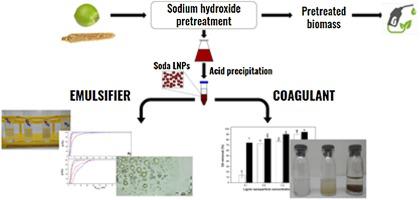当前位置:
X-MOL 学术
›
Colloids Surf. A Physicochem. Eng. Aspects
›
论文详情
Our official English website, www.x-mol.net, welcomes your feedback! (Note: you will need to create a separate account there.)
Fabrication of hollow polymer microcapsules and removal of emulsified oil from aqueous environment using soda lignin nanoparticles
Colloids and Surfaces A: Physicochemical and Engineering Aspects ( IF 5.2 ) Pub Date : 2020-10-01 , DOI: 10.1016/j.colsurfa.2020.125260 Carlos Eduardo de Araújo Padilha , Cleitiane da Costa Nogueira , Stephanie Caroline Bivar Matias , José Daladiê Barreto da Costa Filho , Domingos Fabiano de Santana Souza , Jackson Araújo de Oliveira , Everaldo Silvino dos Santos
Colloids and Surfaces A: Physicochemical and Engineering Aspects ( IF 5.2 ) Pub Date : 2020-10-01 , DOI: 10.1016/j.colsurfa.2020.125260 Carlos Eduardo de Araújo Padilha , Cleitiane da Costa Nogueira , Stephanie Caroline Bivar Matias , José Daladiê Barreto da Costa Filho , Domingos Fabiano de Santana Souza , Jackson Araújo de Oliveira , Everaldo Silvino dos Santos

|
Abstract Lignin-based materials have been explored as a way to minimize dependence on petroleum products and consolidate valorization schemes of lignocellulosic biomass. Soda lignins have peculiar properties and can generate lignin nanoparticles (LNP) with the potential ability to solve emulsification/demulsification problems. The present study focuses on the use of soda LNPs for fabrication of polymer microcapsules via Pickering emulsion template and for removing emulsified oil from aqueous environment. Structural characteristics of lignins recovered from corn cob (CC) and green coconut fibre (GCF) were evaluated after analyses of chemical composition, thermal degradation and infrared spectroscopy. Both LNPs were obtained by pH-shifting method and showed low absolute values of zeta potential. LNPs provided good emulsification capacity (emulsification index > 40 % at 5.00 g/L LNP) and micrometer-scale droplets in oil-water Pickering emulsions. LNPs have been successful as a stabilizing agent in the preparation of microcapsules of poly(methyl methacrylate) (PMMA) and polycaprolactone (PCL), in which size was strongly dependent on the LNP concentration. Hollow PCL microcapsules were manufactured by stabilization with GCF-LNP, but did not show to be stable in experiments involving CC-LNP. In addition, the tendency of soda LNPs to form aggregates was used as a mechanism to remove emulsified oil, which made it possible to remove up to 90.6 % for CC-LNP and 94.4 % for GCF-LNP experiments.
中文翻译:

使用苏打木质素纳米颗粒制备中空聚合物微胶囊并从水性环境中去除乳化油
摘要 木质素基材料已被探索作为一种减少对石油产品的依赖和巩固木质纤维素生物质价值的方法。纯碱木质素具有特殊的性质,可以生成木质素纳米颗粒 (LNP),具有解决乳化/破乳问题的潜在能力。本研究的重点是使用苏打 LNP 通过 Pickering 乳液模板制造聚合物微胶囊以及从水性环境中去除乳化油。在对化学成分、热降解和红外光谱进行分析后,评估了从玉米芯 (CC) 和绿色椰子纤维 (GCF) 中回收的木质素的结构特征。两种 LNPs 都是通过 pH 转移方法获得的,并且显示出较低的 zeta 电位绝对值。LNP 在油水 Pickering 乳液中提供了良好的乳化能力(在 5.00 g/L LNP 时乳化指数 > 40%)和微米级液滴。LNP 已成功用作制备聚甲基丙烯酸甲酯 (PMMA) 和聚己内酯 (PCL) 微胶囊的稳定剂,其中尺寸在很大程度上取决于 LNP 浓度。中空 PCL 微胶囊是通过使用 GCF-LNP 稳定化制造的,但在涉及 CC-LNP 的实验中并未表现出稳定。此外,苏打 LNP 形成聚集体的趋势被用作去除乳化油的机制,这使得 CC-LNP 和 GCF-LNP 实验可以去除高达 90.6% 和 94.4%。LNP 已成功用作制备聚甲基丙烯酸甲酯 (PMMA) 和聚己内酯 (PCL) 微胶囊的稳定剂,其中尺寸在很大程度上取决于 LNP 浓度。中空 PCL 微胶囊是通过使用 GCF-LNP 稳定化制造的,但在涉及 CC-LNP 的实验中并未表现出稳定。此外,苏打 LNP 形成聚集体的趋势被用作去除乳化油的机制,这使得 CC-LNP 和 GCF-LNP 实验可以去除高达 90.6% 和 94.4%。LNP 已成功用作制备聚甲基丙烯酸甲酯 (PMMA) 和聚己内酯 (PCL) 微胶囊的稳定剂,其中尺寸在很大程度上取决于 LNP 浓度。中空 PCL 微胶囊是通过使用 GCF-LNP 稳定化制造的,但在涉及 CC-LNP 的实验中并未表现出稳定。此外,苏打 LNP 形成聚集体的趋势被用作去除乳化油的机制,这使得 CC-LNP 和 GCF-LNP 实验可以去除高达 90.6% 和 94.4%。
更新日期:2020-10-01
中文翻译:

使用苏打木质素纳米颗粒制备中空聚合物微胶囊并从水性环境中去除乳化油
摘要 木质素基材料已被探索作为一种减少对石油产品的依赖和巩固木质纤维素生物质价值的方法。纯碱木质素具有特殊的性质,可以生成木质素纳米颗粒 (LNP),具有解决乳化/破乳问题的潜在能力。本研究的重点是使用苏打 LNP 通过 Pickering 乳液模板制造聚合物微胶囊以及从水性环境中去除乳化油。在对化学成分、热降解和红外光谱进行分析后,评估了从玉米芯 (CC) 和绿色椰子纤维 (GCF) 中回收的木质素的结构特征。两种 LNPs 都是通过 pH 转移方法获得的,并且显示出较低的 zeta 电位绝对值。LNP 在油水 Pickering 乳液中提供了良好的乳化能力(在 5.00 g/L LNP 时乳化指数 > 40%)和微米级液滴。LNP 已成功用作制备聚甲基丙烯酸甲酯 (PMMA) 和聚己内酯 (PCL) 微胶囊的稳定剂,其中尺寸在很大程度上取决于 LNP 浓度。中空 PCL 微胶囊是通过使用 GCF-LNP 稳定化制造的,但在涉及 CC-LNP 的实验中并未表现出稳定。此外,苏打 LNP 形成聚集体的趋势被用作去除乳化油的机制,这使得 CC-LNP 和 GCF-LNP 实验可以去除高达 90.6% 和 94.4%。LNP 已成功用作制备聚甲基丙烯酸甲酯 (PMMA) 和聚己内酯 (PCL) 微胶囊的稳定剂,其中尺寸在很大程度上取决于 LNP 浓度。中空 PCL 微胶囊是通过使用 GCF-LNP 稳定化制造的,但在涉及 CC-LNP 的实验中并未表现出稳定。此外,苏打 LNP 形成聚集体的趋势被用作去除乳化油的机制,这使得 CC-LNP 和 GCF-LNP 实验可以去除高达 90.6% 和 94.4%。LNP 已成功用作制备聚甲基丙烯酸甲酯 (PMMA) 和聚己内酯 (PCL) 微胶囊的稳定剂,其中尺寸在很大程度上取决于 LNP 浓度。中空 PCL 微胶囊是通过使用 GCF-LNP 稳定化制造的,但在涉及 CC-LNP 的实验中并未表现出稳定。此外,苏打 LNP 形成聚集体的趋势被用作去除乳化油的机制,这使得 CC-LNP 和 GCF-LNP 实验可以去除高达 90.6% 和 94.4%。



























 京公网安备 11010802027423号
京公网安备 11010802027423号